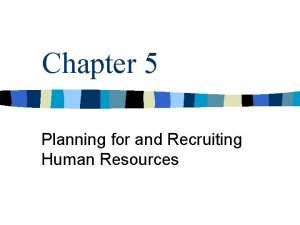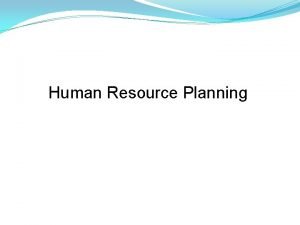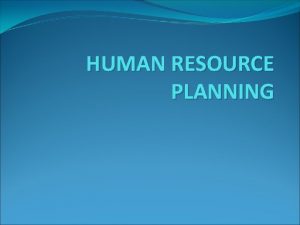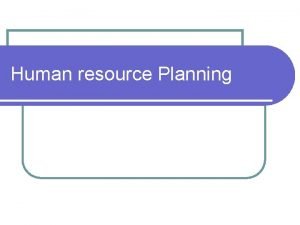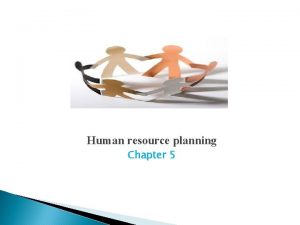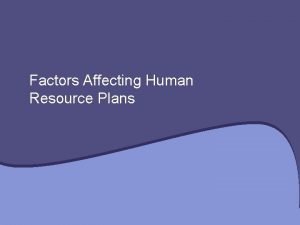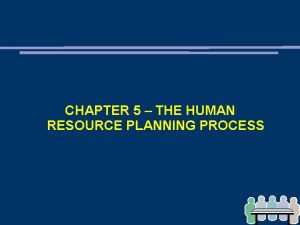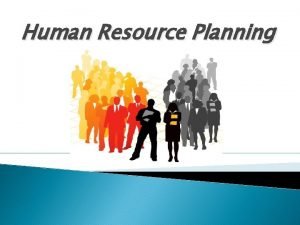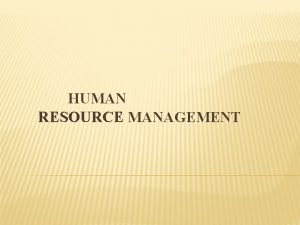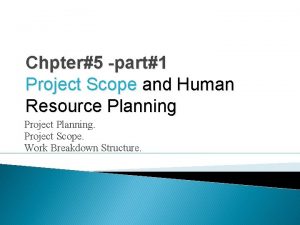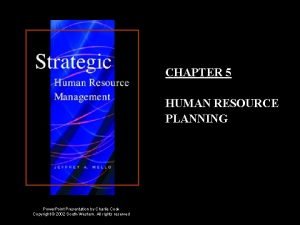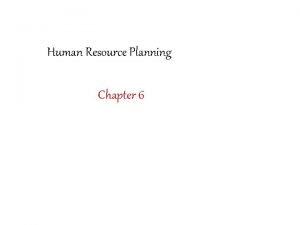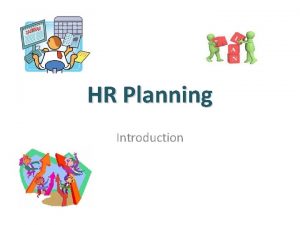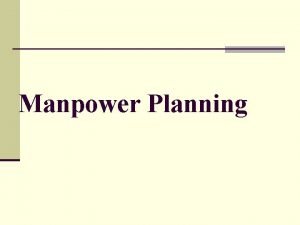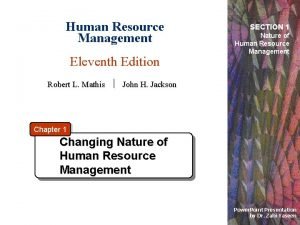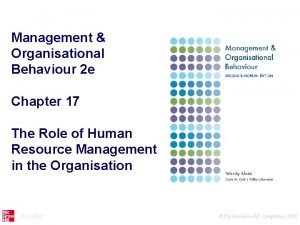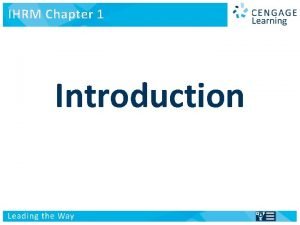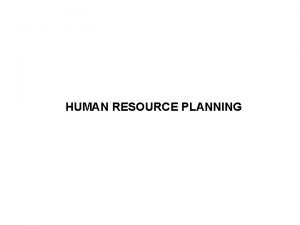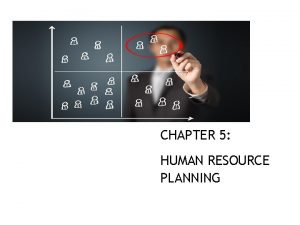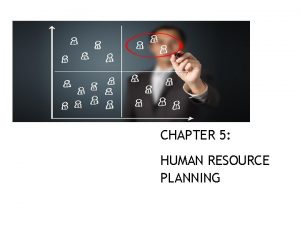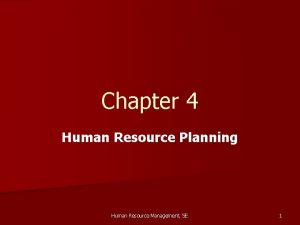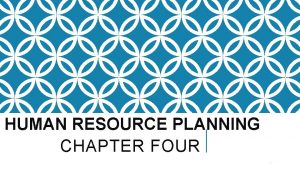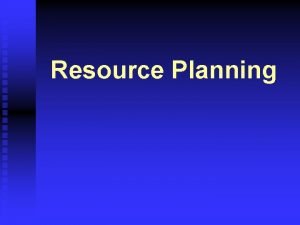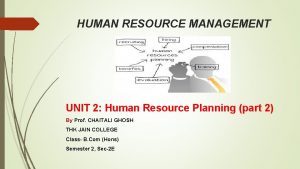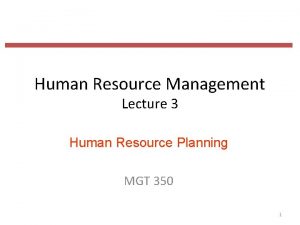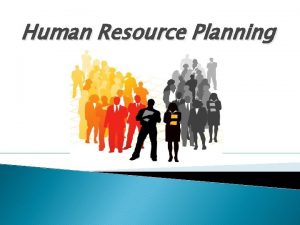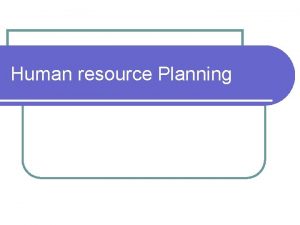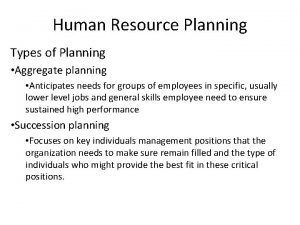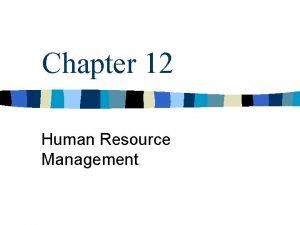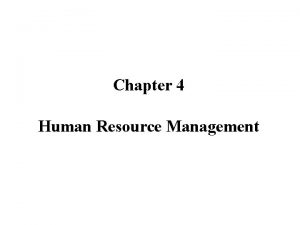Human resource planning Chapter 5 Chapter outline What






















- Slides: 22

Human resource planning Chapter 5

Chapter outline: • What is Human Resource Planning (HRP) • How HRP Relates to Organizational Planning • Time Frame of HRP • HRP: An Evolving Process • Steps in the HRP Process

What is Human Resource Planning (HRP) It is “the system of matching the supply of people— internally (existing employees) and externally (those to be hired or searched for)—with the openings the organization expects to have over a given time frame” v Also referred to as workforce planning or personnel planning. v The long-term success of any organization depends on having the right people in the right jobs at the right time. v all organizations engage in human recourses planning either formally or informally. some organizations do a good job and others a poor job.

Problems of poor HRP Poor human resource planning can also cause substantial problems in the short term. examples: Ø Ø The CEO of a successful company retires unexpectedly because of recent health issues. There is no obvious replacement. Despite an aggressive search, an important middle management position in a high-technology organization has gone unfilled for six months. Productivity in the section has plummeted.

How HRP Relates to Organizational Planning q q Any human resource plan must be derived from the strategic and operational plans of the organization. HRP Focuses on how organization can become better positioned and equipped to compete in its industry.

Strategy- linked HRP All managers, especially line managers, should view human resource planning as one of their most important job responsibilities. The process requires a joint effort by the individual managers and human resource personnel. Strategy- linked HRP : (is based on a close working relationship between human resource staff and line managers) § § § Human resource managers serve as consultants to line managers concerning the people-management implications of business objectives and strategies. Line managers have a responsibility to respond to the business implications of human resource objectives and strategies. the commitment of top management, which should be clear to other managers and employees.

Time Frame of HRP Organizational plans are frequently classified as ØShort-range (zero to two years) ØIntermediate range (two to five years) ØLong-range (beyond five years) ◦ Factors affecting the time frame of HRP: 1. Demand (number of employees required to achieve organizational objectives ) 2. Supply (they have too much labor) 3. Net needs (additional human recourses requirements while the organization has it’s current human resources )

HRP – An Evolving Process An organization’s human resource planning efforts should be viewed not as an all-or nothing process but as falling at some point along a continuum. At one end of this continuum are those organizations that do no human resource planning; at the other end are those that completely integrate long-range human resource planning into their strategic business plans. five stages, or benchmarks, along this continuum.

HRP – An Evolving Process ◦ Stage 1 – Companies have no long-term business plans, and do little or no human resource planning ◦ Stage 2 – Companies have a long-term business plan, but tend to be skeptical of HRP. At the same time , such companies do realize to some degree that human resource planning is important. ◦ Stage 3 – Companies engage in some aspects of human resource planning, but these efforts are not integrated into the long-range business plan. ◦ Stage 4 – Companies do a good deal of human resource planning, and their top managers are enthusiastic( keen) about the process. These companies have at least one human resource component integrated into the long-range plan. ◦ Stage 5 – Companies treat human resource planning as an important and vital part of their long-term business plan. (companies at this stage are highly enthusiastic about HRP)

Steps in HRP Process 1) Determining impact of organization’s objectives on specific organizational units 2) Defining skills, expertise, and total number of employees (demand) required to achieve organizational and departmental objectives 3) Determining additional (net) human resource requirements in light of organization’s current human resources 4) Developing action plans to meet anticipated human resource needs

Steps in Human Resource Planning Process

1 - Determining Organizational Objectives Organizational objectives, which give the organization and its members direction and purpose, should be stated in terms of expected results. Ø Cascade approach • Objective-setting process designed to involve all levels of management in the organizational planning process Ø It is not a form of top-down planning The idea is to involve all levels of management in the planning process. Ø Ensures that the objectives are communicated and coordinated through all levels of the organization Ø Involves both operating managers and human resource personnel in overall planning process Ø In the early stages, human resource personnel can influence objective setting by providing information about organization’s human resources

Cascade Approach to Setting Objectives

2 -Determining Skills and Expertise Required (Demand- Need) v Important to determine skills and abilities required to meet objectives rather than look at skills and abilities of present employees. Ex How ? 1. A good Starting point is to review current job descriptions. 2. Once that has been accomplished, managers are in a better position to determine the skills and expertise necessary to meet their objectives. 3. Translate needed skills and abilities into types and numbers of employees.

Methods of Forecasting Human Resource Needs Methods forecasting human resource needs can be either judgmentally or mathematically based. Judgmental Methods 1 -Managerial Estimates 2 -Delphi Technique 3 - Scenario Analysis 1 -Managerial estimates – § Calls on managers to make estimates of future staffing needs based on past experience. These estimates can be made by top-level mangers to down, vice-versa( by lower-level managers and passed up for further revision), or by some combination of upper- and lower-level managers.

2 -Delphi technique – § Each member of a panel of experts independently estimates of what the future demand will be. § An intermediary then presents each expert’s forecast and assumptions to the other members of the panel § Each expert is then allowed to revise his or her forecast as desired § This process continues until some agreement emerges 3 - Scenario analysis Developed in brainstorming sessions with line managers and HR managers who forecast what they think their workforce will look like in the future (five years for example) when the picture is ready they can work backwards to identify key change points. Using work force environmental scanning data to develop alternative work force scenarios. The biggest advantage of scenario analysis is that it encourages open, out-ofthe-box thinking.

Methods of Forecasting Human Resource Needs – Mathematical Methods: With using user-friendly software and computers, and it Include various statistical and modeling methods Mathematical Methods 1 -Statistical Methods 2 -Modeling Methods 1 -Statistical methods Uses historical data in some manner to project future demand 2 -Modeling methods Usually provide a simplified abstraction of the human resource demands throughout the organization and by Changing the input data allows testing the human resource results of different demand scenarios to be tested.

3 -Determining Additional (Net) Human Resource Requirements Once a manager has determined the types and numbers of employees required, he or she analyzes these estimates in light of the current and anticipated human resources of the organization. Skills inventory consolidates information about the organization’s human resources. It provides basic information on all employees, including, in its simplest form, a list of the names, certain characteristics, and skills of employees. These information is used as input into promotion and transfer decisions. So, it should contain information about each employee’s portfolio of skills and not just those relevant to the employee’s current job.

Skills inventory : o seven categories of information that should be included in a skills inventory: Personal data – Age, sex, marital status ◦ Skills – Education, job experience, training ◦ Special qualifications – Membership in professional groups, special achievements ◦ Salary and job history – Present and past salary, dates of raises, various jobs held ◦ Company data – Benefit plan data, retirement information, seniority ◦ Capacity of individual – Test scores on psychological and other tests, health information ◦ Special preferences of the individual – Geographic location, type of job

Advantages Determining Additional (Net) Human Resource Requirements Advantages: 1. accurately evaluate skills available within organization 2. Helps determine promotion and transfer decisions 3. Necessary for making other decisions, such as whether to bid on a new contract or introduce a new product 4. helps in planning future employee training and management development programs 5. helps in recruiting and selecting new employees

4 - DEVELOPING ACTION PLANS Once the net human resource requirements have been determined, managers must develop action plans for achieving the desired results. § Adding human resources. (By temporary or permanently hiring ) Contingent workers and outsourcing. Reducing human resources • Downsizing • Layoffs • Terminations • Early retirements • Voluntary resignation inducements. • Other ways: Job sharing or Transfer.

Environmental Factors Affecting Human Resource: p. 99 Ø Many external factors influence organization’s objectives and human resource needs 1. Government influences Laws and regulations imposed by local, state, and federal governments 2. General economic conditions Recession or economic boom level of unemployment 3. Competition Direct competitors Businesses that compete for same labor and other resources 4. Changes in workforce Workforce composition and its work habits Changes in technology
 Chapter 5 personnel planning and recruiting
Chapter 5 personnel planning and recruiting Why is forecasting important in human resource planning
Why is forecasting important in human resource planning Long term hr planning
Long term hr planning Human resources planning definition
Human resources planning definition Human resource planning meaning
Human resource planning meaning Human resource plan definition
Human resource plan definition 5 stages of human resource planning
5 stages of human resource planning Human resource management exam paper
Human resource management exam paper Social factors affecting human resource management
Social factors affecting human resource management Supply forecasting techniques in hrp
Supply forecasting techniques in hrp Human induction meaning
Human induction meaning Human resource planning introduction
Human resource planning introduction Human resources planning definition
Human resources planning definition Wbs human resource management
Wbs human resource management Human resource planning powerpoint presentation
Human resource planning powerpoint presentation Hr planning meaning
Hr planning meaning Definition of planning
Definition of planning Advantages of manpower planning
Advantages of manpower planning Human resource management nature
Human resource management nature What is markov analysis in hrm
What is markov analysis in hrm Harvard model of hrm
Harvard model of hrm Difference between hrm and ihrm
Difference between hrm and ihrm Requisites for successful hrp
Requisites for successful hrp
